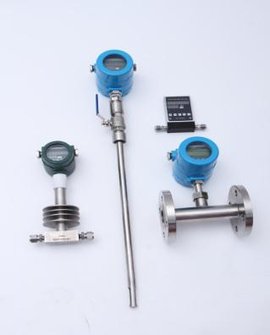
Coriolis mass flowmeters measure the force resulting from the acceleration caused by mass moving toward (or away from) a center of rotation. This effect can be experienced when riding a merry-go-round, where moving toward the center will cause a person to have to ”lean into” the rotation so as to maintain balance. As related to flowmeters, the effect can be demonstrated by flowing water in a loop of flexible hose that is ”swung” back and forth in front of the body with both hands. Because the water is flowing toward and away from the hands, opposite forces are generated and cause the hose to twist. They represent about 21% of all flowmeters sold.
In a Coriolis mass flowmeter, the ”swinging” is generated by vibrating the tube(s) in which the fluid flows. The amount of twist is proportional to the mass flow rate of fluid passing through the tube(s). Sensors and a Coriolis mass flowmeter transmitter are used to measure the twist and generate a linear flow signal.
This technology has high accuracy, can handle sanitary applications, is approved for custody transfer and is highly reliable and low maintenance. Mass flow is more important than volume for fluids intended for the production of energy. These include petroleum liquids and natural gas both compressed and liquefied. The cost is high, especially for line sizes above four inches. Pressure drop can be a consideration for ”U” shaped tube designs and high viscosity fluids.
Coriolis mass flowmeters measure the mass flow of liquids, such as water, acids, caustic, chemicals, and gases/vapors. Because mass flow is measured, the measurement is not affected by fluid density changes. Be particularly careful when using Coriolis mass flowmeters to measure gas/vapor flows because flow rates tend to be low in the flow range (where accuracy is degraded). Also, in gas/vapor applications, large pressure drops across the flowmeter and its associated piping can occur.
This flowmeter can be applied to sanitary, cryogenic, relatively clean, and corrosive liquids and gases/vapors in pipes smaller than 6-12 inches. General applications are found in the water, wastewater, mining, mineral processing, power, pulp and paper, petroleum, chemical, and petrochemical industries. Materials of construction are generally limited to stainless steel and Hastelloy C. Straight-tube designs are available to measure some dirty and/or abrasive liquids.
Many applications for Coriolis mass flowmeters are found in chemical processes where fluids can be corrosive and otherwise difficult to measure. In addition, the relative insensitivity to density allows Coriolis mass flowmeters to be applied in applications where the physical properties of the fluid are not well known. These flowmeters can also be used in chemical feed systems found in most industries.
The industries in order of higher to lower are chemical, oil and gas, food and beverage, pharmaceutical, pulp and paper, power, metals and mining, and water and wastewater followed by all others in small amounts.
If the pressure drop is acceptable, operate a Coriolis mass flowmeter in the upper part of its flow range because operation at low flow rates can degrade accuracy. Note that high viscosity fluids increase the pressure drop across the flowmeter. For liquid flows, make sure that the flowmeter is completely full of liquid. Be especially careful when measuring gas/vapor flow with Coriolis mass flowmeters. Pay special attention to installation because pipe vibration can cause operational problems.
新聞資訊